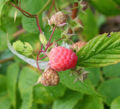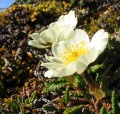Rosaceae
| Rosaceae |
|---|

|
| Scientific Classification |
|
| Genera |
|
Rosaceae consists of over 3000 species including fruit trees, shrubs, and ornamental flowers. The type-genus of which, the rose, is held as a symbol of love throughout cultures.
Anatomy
The family Rosaceae are all angiosperms, that is, flowering plants. The plants grow on stalks which put out leaves, and eventually flower out to produce seeds. The seed that develops is a dicotyledon, meaning there are two initial leaves that come out of the seed during germination. Many of the fruits (ovaries) in this family are edible, such as the cherry, pear, and apple trees.
A common characteristic in Rosaceae is the woody growth on stems and trunks. The trees, roses, and others have bark, with little herbaceous growth.
Reproduction
Plants in the family Rosaceae reproduce sexually through pollination, which is often assisted by insects. Bees, butterflies, and hummingbirds are examples pollenators. As they feed upon flower from one flower they transfer the pollen from another.
When the ovaries containing the seeds are ripe, they drop off to create a new growth and reproduce somewhere else. Humans and other creatures often eat these ovaries as in the case with apples, pears, and cherries.
Ecology
Plants in the family Rosaceae are found all over the world. They are a typically hardy, and fairly drought tolerant. In the wild, they are usually found in moderate climates in more sunny areas, with frequent rain. Plants like the wild roses thrive best in full sun.
People cultivate and keep the members of Rosaceae for food and decoration. The trees are harvested for their fruit, and the roses are cut to give to others as a symbol of affection.
Gallery
Cherry Blossom
(P. Jamasakura)
Genus: PrunusRosa 'Carlita'
Genus: RosaStrawberry
Genus: FragariaRosa 'Blessings'
Genus: RosaLady's Mantle
(A. vulgaris)
Genus: AlchemillaMountain Avens
(D. octopetala)
Genus: DryasBeach Plum
(P. maritima)
Genus: Prunus(C. laevigata)
Genus: CrataegusWild Rose
Genus: Rosa(G. coccineum)
Genus: Geum











